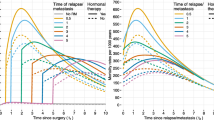Abstract
In some problems in survival analysis there may be more than one plausible measure of time for each individual. For example mileage may be a better indication of the age of a car than months. This paper considers the possibility of combining two (or more) time scales measured on each individual into a single scale. A collapsibility condition is proposed for regarding the combined scale as fully informative regarding survival. The resulting model may be regarded as a generalization of the usual accelerated life model that allows time-dependent covariates. Parametric methods for the choice of time scale, for testing the validity of the collapsibility assumption and for parametric inference about the failure distribution along the new scale are discussed. Two examples are used to illustrate the methods, namely Hyde's (1980) Channing House data and a large cohort mortality study of asbestos workers in Quebec.
Similar content being viewed by others
References
D. R. Cox, “Regression models and life-tables” (with discussion),J. Roy. Statist. Soc. B, vol. 34 pp. 187–220, 1972.
D. R. Cox and D. Oakes,Analysis of Survival Data, Chapman and Hall: London, 1984.
V. T. Farewell and D. R. Cox, “A note on multiple time scales in life testing,”Appl. Statist., vol. 28 pp. 73–75, 1979.
J. Hyde, “Survival analysis with incomplete observations,” inBiostatistics Casebook, R. G. Miller, B. Efron, B. W. Brown, L. E. Moses (eds.), New York: Wiley, 1980, pp. 31–46.
F. D. K. Liddell, J. C. McDonald, and D. C. Thomas, “Methods of cohort analysis: appraisal by application to asbestos mining” (with discussion),J. Roy. Statist. Soc. A, vol. 140 pp. 469–491, 1977.
J. C. McDonald, F. D. K. Liddell, A. Dufresne, and A. D. McDonald, “The 1891–1920 birth cohort of Quebec chrysotile miners and millers: mortality 1976–88,”Brit. J. Ind. Med., vol. 50 pp. 1073–1081, 1993.
J. C. McDonald, F. D. K. Liddell, G. W. Gibbs, G. E. Eyssen, and A. D. McDonald, “Dust exposure and mortality in chrysotile mining, 1910–1975,”Brit. J. Ind. Med., vol. 37 pp. 11–24, 1980.
W. Nelson, “Hazard plotting for incomplete failure data,”J. Qual. Technology, vol. 1 pp. 27–42, 1969.
J. Robins, “Estimation of the time-dependent accelerated failure time model in the presence of confounding factors,”Biometrika, vol. 79 pp. 321–334, 1992.
J. Robins and A. A. Tsiatis, “Semiparametric estimation of an accelerated failure time model with time-dependent covariates,”Biometrika, vol. 79 pp. 311–320, 1992.
D. C. Thomas, “General relative risk models for survival time and matched case-control analysis,”Biometrics, vol. 37 pp. 673–686, 1981.
Author information
Authors and Affiliations
Rights and permissions
About this article
Cite this article
Oakes, D. Multiple time scales in survival analysis. Lifetime Data Anal 1, 7–18 (1995). https://doi.org/10.1007/BF00985253
Received:
Accepted:
Issue Date:
DOI: https://doi.org/10.1007/BF00985253




